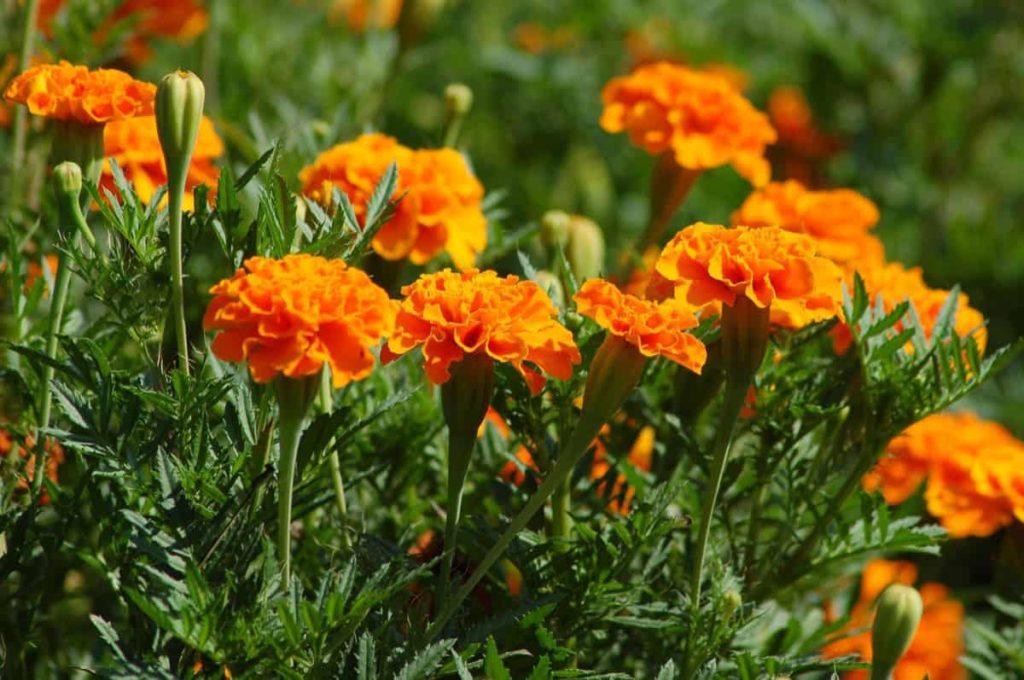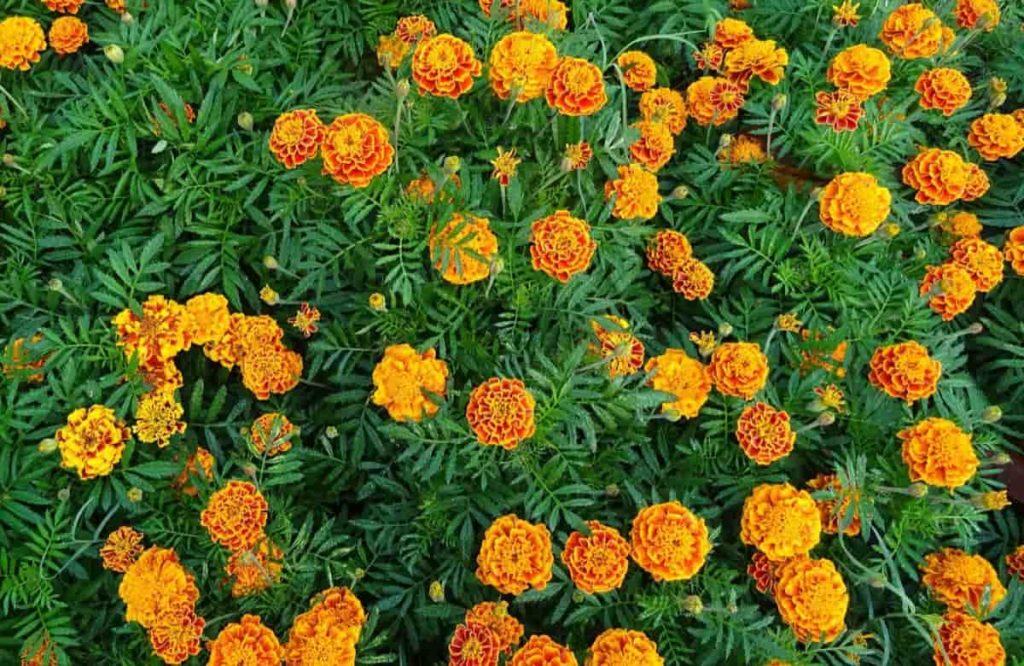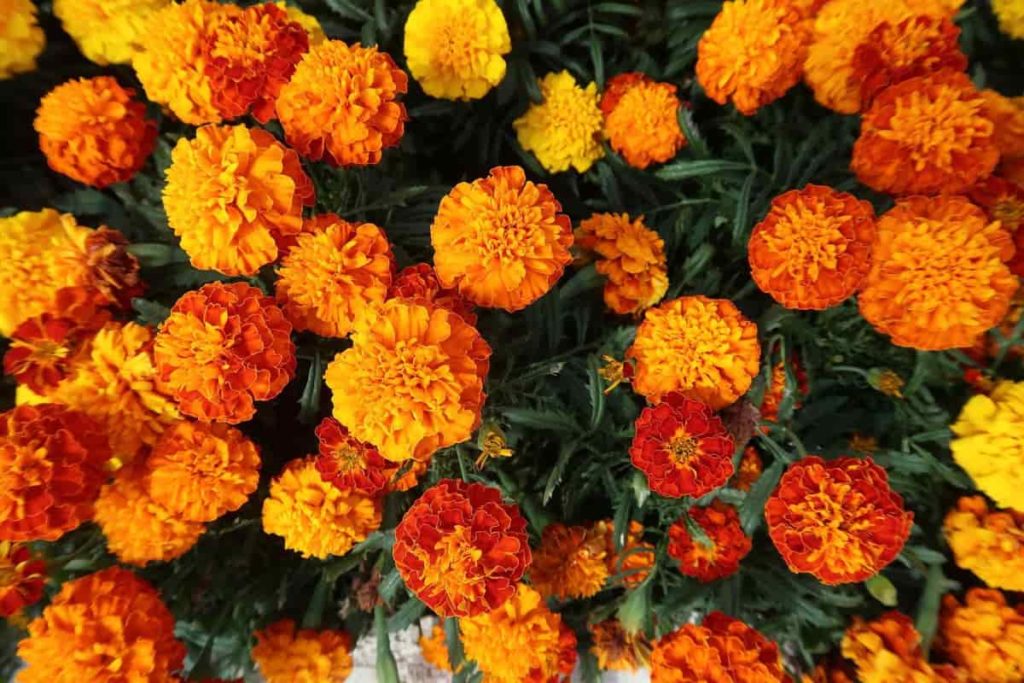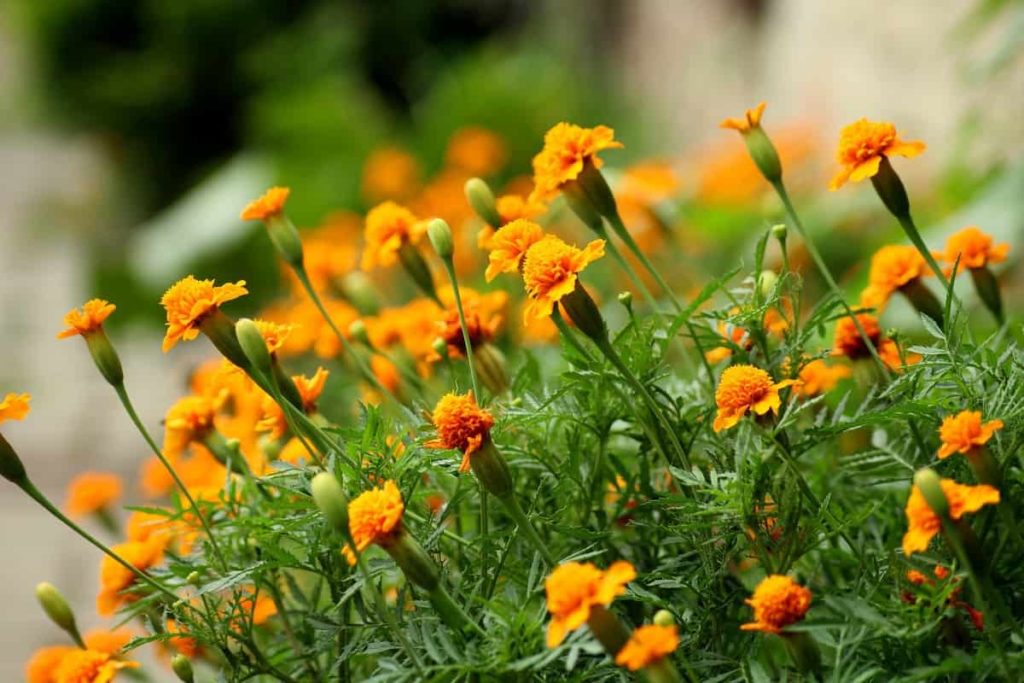Marigolds have been a popular flower among home gardeners for decades and, for many reasons, are still so popular today. These easy, low-maintenance plants will bloom all season in the hottest climate as well. Marigold seeds and transplants are readily available during the growing season and can add to any full-sun patio or garden area.

Marigolds can prevent some pests from your garden and other plants, but that doesn’t mean they are invincible. Marigolds are not prone to many pests in the garden, but some can attack the Marigold from time to time. Marigolds are common companion plants that are seen to repel many pests.
They are resistant to pest problems, but diseases in Marigold plants are sometimes a problem. The most frequently found diseases are fungi which affect the stems, leaves, and roots. However, diagnosis and treatment of Marigold plant diseases are relatively easy. Most can be fixed using different cultural methods. Let’s check out 20 common Marigold plant problems below.
Common Marigold plant problems
Marigold seedlings are not growing
Not enough sunlight
Marigolds are from the Sunflower family. That’s why you should keep your plant where it can have direct access to sunlight.
Solution –Marigold plant getting 4 to 6 hours of light is important for its growth. With this in mind, if you have noticed that your Marigold seedlings are not growing, lack of sunlight can be the main reason for this. You can try planting a seedling inside a pot and then place it where direct sunlight can come in contact with the plant.
Excess water content
Marigolds are drought-resistant flowering plants that make them an excellent option for beginners. However, you should note that these flowers still need a small amount of water to be in their best condition. The main problem people get is that they give a lot of water to the plant.
Solution – Marigold flowers require only enough water to keep the soil around their roots moist. If you use too much water, excess water will eventually accumulate inside the soil. It starts suffocating the plant and prevents it from growing further. So, you should keep checking your plant.
Another way is to create small escape routes inside the soil. The escape route removes all the excess water without any problems. If you grow your seedlings in a pot, it should make a move to leave a small hole underneath it. You can also add a rock if the soil gets out of the escape route.
Not enough nutrients
Another reason your Marigold seedlings are not growing may be that the plant is not getting enough nutrients. It can be quite annoying as the flower is known to be easy to maintain.
Solution – When dealing with this problem, you can add fertilizer to the plant. Keep it going until the seedlings become a plant that blooms in new flowers.
Marigold plants are not flowering
Fertilizer
If you have poor soil, limit the fertilizer to light feeding. Marigold in rich (or over-composted) soil may be lush green but can produce some flowers. This is one of the main reasons for the absence of Marigold plants flowering.
Solution – You should amend the soil from time to time.
In case you missed it: Growth Stages of Flowering Plants: Rose, Marigold, Hibiscus, Dahlia, Gerbera Daisy, and Jasmine

Sunshine
Marigolds are sun-loving plants. In the shade, they can produce leaves, but some flowers will appear. One of the most common reasons for the lack of flowers on the Marigold is the lack of sunlight.
Solution – If this is the problem, move the plants to a point where they are exposed to full sunlight all day.
Soil
Marigolds will not bloom in soggy soil, and a fatal disease can be caused called root rot.
Solution – Marigolds are not fussy about the type of soil, but good drainage is essential.
Water
Water at plant base to keep leaves dry. Avoid more water to avoid root rot and other moisture-related diseases.
Solution – Keep the Marigold moist in the first few days after planting. Once they are established, water them deeply once a week.
Pests
Most insects are not attracted to the Marigold, but spider mites can be a problem, especially in dry, dusty conditions. Furthermore, stress or unhealthy Marigold plant can be disturbed by aphids.
Solution – Proper maintenance and regular application of insecticidal soap spray should be taken care of.
Yellow Leaves
Powdery Mildew
When leaves are severely affected due to powdery mildew, they can twist or turn yellow due to this infection.
Solution – As soon as you see this powdery mildew, wash it thoroughly with the hose. You can prevent further infection by thinning your plants so the wind can pass between them.
Aster yellows
When you have Marigolds with yellow leaves, your plants may be affected by aster yellow disease. Aster yellow is caused by a very small organism known as phytoplasma. When this phytoplasma enters the leaves of plants, they become colorless in yellow or red.
Solution – You cannot treat the Marigold with Aster yellow. Dig them up, destroy them, and try again.
Leaf burn
When you see your Marigold leaves turning yellow, ask yourself if you have recently given any micronutrient solutions to plants. If so, your plants may burn leaves because of extra borons, manganese, or other nutrients. If the yellow leaves on the Marigold are the yellow color of the leaf tips and margins, the leaves in your plants burn.
Solution – Prevent this problem by carefully measuring micronutrient solutions before applying.
Pest attacks
When you see leaves yellowing or browning, it can also be due to pests. While Marigolds are not bothered by too many pests and can prevent most of them, plants can occasionally find themselves prone to pests like mealybugs.
Solution – Treatment with neem oil can help with this.
Seedlings die after sprouting
Marigolds are easy to grow from seeds; it is not uncommon for gardeners to have trouble dying faster than when they are starting to grow, usually when the delicate stem becomes black, wilt, and dies. It is a perfect example of damping-off a fungal disease caused by many different fungi species.
Solution – There is no cure for damping-off the disease. Still, you can prevent its occurrence by using only a sterile potting mix, using clean pots, providing plenty of space between and good air circulation between seedlings, and watering the seedling pots and trays from the bottom watering them from the top. The damping-off fungi prefer cool conditions, so keeping the seedling tray warm can also help prevent it.
In case you missed it: Best Fertilizer for Marigold: Organic, Homemade, Natural, NPK, and Compost Manure

Tall Marigolds flop over
Taller species of Marigolds 3 feet or longer can cause heavy flop on top due to winds and heavy rains.
Solution – To prevent this, you can bury plants in extra depth, stripping off lower leaves and planting so that these exposed stem nodes are buried. This creates an extra-large root system that can be enough to keep the plant straight, even in moderately strong winds. It also helps remove heavy spent flowers immediately after blooming to prevent the plant from becoming too heavy. And, of course, you can stake your plants if needed.
Plants weaken in the middle of summer
Marigolds can sometimes be sparse and spindly during the hottest part of midsummer. This is particularly likely in a very hot climate. Solution – Many gardeners like quickly prune back plants as these hot stretches begin. After pruning, plants always come back strong and produce good growth, and many flowers as the summer begin to cool down again in the late summer and early fall.
Marigold leaves are turning purple
The lack of phosphorus is the first concern of Marigold leaves being purple. Besides, powdery mildew on the Marigold is also an important reason for the problem. Fungal infections also play an important role. White mold infections such as fungal infections also result in purple Marigold leaves.
Lack of phosphorus
The purple leaves can be due to several factors. But the most prevalent is the lack of phosphorus. Phosphorus is important for plant growth, focusing on roots, blooming, and fruit.
Solution – Start with soil analysis. A soil test will show the amount of phosphorus that is accessible. You can use phosphorus levels, bone meal, rock phosphate, and superphosphate. Signs of phosphorus deficiency are common in early spring.
Powdery mildew
Powdery mildew causes white mold formation on Marigold flowers. As a result, the Marigold leaves gradually turn purple. Overwater and overfertilization with nitrogen can also increase fungus growth.
Solution – You should place plants far away to allow proper airflow. Plant fungicides on your plants in spring before powdery mildew appears. Then continue throughout the year as needed. You should mix a teaspoon of baking soda in a quart of water to quickly fix it and spray the plants in large quantities.
White mold infection
As the name says, it causes a fluffy white mold on the damaged leaves and trunks. Other symptoms include wilted leaves and dry, brittle, tan-colored stems in the infection area.
Solution –You should remove any sick Marigold plants from the garden. You can burn or bury sick plants from where you want to plant them. Give enough space to new plants. Do this when replanting to allow ventilation and keep the leaves dry.
Leggy Marigold plants
Crowded Marigolds cause weak and leggy plants.
Solution – As soon as you see the sprouting as you emerge from the soil, move the sprouted Marigold seed pots into a bright, sunny window. Marigold needs at least 6 hours of bright sunlight daily and is much better at growing a strong plant.
Check the potting mix daily to ensure the Marigold has good moisture. Remove the tray and pour water after the vessels come out to prevent excess water from leaking into the soil and make it very moist. More water can cause plants to become taller. Read the package carefully on your plant fertilizer, and use a dilute solution to fertilize the growing Marigold seedlings.
Marigold leaves turn brown
Marigolds are not tolerant of low pH soil. This produces manganese or iron toxicity, making the leaves brown and stained.
Solution – If the soil pH is too low, you will need to modify the soil with lime for next year’s plants.
New growth yellow and die
While inadequate nutrients can cause many problems, malnutrition excess in the soil can also lead to many plant diseases. Burning leaves, where leaf tips and new growth turns yellow and dead, result from extra borons, manganese, or molybdenum.
Solution – When using fertilizer, ensure your soil needs the nutrients it contains. Soil testing may be necessary to determine which nutrients are already present in the ground.
Marigold leaves wilting
The wilting Marigold can only be thirsty, but a lethal disease can attack it.
Solution – The Marigold needs water, especially immediately after transplant. They will wilt if they don’t get enough water. Then if the water is still not coming, die.
There is another possible reason for the excessive water to wilt.
Solution – Root rot, stem rot, or crown rot is caused when too much water to plants, but the soil does not drain well. Too much moisture causes various severe fungi/bacterial wilting diseases to affect the Marigold. These include Verticillium wilt and southern bacterial wilting. You can use fungicides to prevent this problem, but fungicides do not work well. You should be removed and dispose of the plants and surrounding soil.
In case you missed it: Marigold Gardening For Beginners – Planting FAQs

Pests
Aphids
Aphids eat the stems and leaves of the Marigold plant.
Solution – Shooting your affected Marigolds with a strong explosion of water from the garden’s hose is often enough to remove and control the insect. In more serious cases, spraying aphids with neem oil or insecticidal soap will kill pests in contact.
Earwigs
Earwigs are reddish-brown pests, about 3/4 inches long, and sometimes eat at Marigold leaves in the evening.
Solution – Removing common hiding places, such as fallen plant debris, yard waste, and weeds will often solve the problem. Put ½- inch vegetable oil under a small container, the oil will attract earwigs, and insects will fall into the oil and die.
Leaf miners
Leaf miners look like little black and yellow flies. They sometimes lay eggs in your Marigold leaves.
Solution – Keeping your Marigold well filled with water is usually enough to prevent the problem as leaf miners target weak, drought-stressed plants. Cut and discard the affected leaves if you notice clear signs of leaf-miner activity.
Snails and slugs
Snails and slugs can attack the low-hanging parts of your Marigolds.
Solution – Hand-picking and dropping them into a solution made of household ammonia and nine parts of water will also effectively kill them.
In case you missed it: Growing Marigolds in Pots from Seed, Cuttings, Layering

Thrips
Thrips are small, flying pests that suck the juice from Marigold leaves.
Solution – If your Marigold is falling prey to the disease, hang a blue sticky net on a branch of your Marigold. Thrips will get stuck and die. Change the sticking net after covering its surface with pests.
Whiteflies
Whiteflies feed on juice in Marigold leaves and trunks, most common during hot weather.
Solution – Cutting leaves covered in whiteflies will usually keep the insect population low to cause lasting damage. Alternatively, use a hand-held vacuum to suck flies from leaves. For best results, attack this problem in the early morning or late evening, when the insects are slower.
Diseases
Powdery mildew
Powdery mildew is a white, grey powdery substance that forms over leaves. It is commonly found in hot, humid places where leaves remain wet and unable to dry.
Solution – You can treat it by applying simple solutions to the leaves. Mix two tablespoons of Epsom salt in water and pour this solution well on the leaves.
Aster yellow
Easter yellow is a viral disease caused by a minute organism smaller than bacteria that can stunt or deform the Marigold. They cause the base of the plant and are usually yellow. Plant flowers are also usually deformed, taking the form of a stunt or leaf. Eventually, The Marigold can wilt and die.
Solution – Remove the affected plants immediately to control the spread of the disease and sterilize any gardening tools you use to tend to plants. Remove the nearby weeds if you see them attracting leaf hoppers or aphids.
In case you missed it: Growing Hydroponic Marigold – A Full Guide

Rots and blights
Marigolds can also be affected by root, crown, and stem rot, caused by fungi that affect the plant’s crowns and roots. Phytophthora is a common fungus that attacks the Marigold and usually affects plant roots in poorly drained soil. The color of the Marigold leaves can fade and eventually pale and wilt. Since the fungus attacks the roots, plant growth usually stops, and Marigolds can eventually die.
Solution – Remove them from your garden immediately if you find affected plants. To fix this root, stem, and crown rot in your Marigold, avoid too much water so as not to produce excess moisture. Ensure that there is proper drainage in the soil.
Conclusion
Marigolds are hardy plants that usually grow anywhere if conditions are right for the plant. While they are not bothered by many insects, some are attracted to the magnificent Marigold plant and will try to damage it. If you keep it free from pests and diseases, a little care every day will allow your Marigold plant to live a long, colorful, productive life. The Marigold plant is a great addition to your garden and can be planted as a border to repel and have an array of insects that will try and attack other plants in your garden.
- How to Grow Hibiscus from Flower
- Plantation Ideas for Home Decoration: A Beginners Guide
- Flower Garden Designs and Layouts for Beginners
- Planting and Spacing Techniques in Papaya: A Beginner’s Guide
- Growing Gold: Essential Techniques for Planting Pineapples
- How to Make Kalanchoe Plant Bushy: Home Remedies and Solutions
- 11 Reasons Why Your Gardenia is Not Blooming: Home Remedies and Solutions
- Eco Elegance: The Guide to Designing a Drought-Tolerant Landscape
- Gardening on a Slope: Strategies for Hillside Landscaping
- Nourish and Flourish: Top Organic Mulches for Thriving House Plants
- Everything You Want to Know about Indian Mogra Flower: Discover Uses and Growing
- Green Thumb Success: Expert Tips for Cultivating Greenhouse Pumpkins All Year Round
- Maximize Growth & Flavor: The Ultimate Guide to Companion Planting in Herb Gardens
- How to Control Rhododendron Problems Naturally: Home Remedies and Organic Ways to Fix Them
- Natural Magic: The Remarkable Benefits of Cinnamon for Plants
- Best Steps to Revive Dying Tulip with Natural and Organic Treatment
- 10 Reasons Why Your Angel Trumpet is Not Blooming: Remedies and Treatment
- How to Fix Periwinkle Leaf and Flower-Related Problems: Natural Remedies and Solutions
- How to Fix Zinnias Leaf and Flower Problems: Discover Natural and Home Remedies
- Organic Steps to Induce Lemon Tree Flowers: A Comprehensive Guide
- Bloom Booster: Crafting the Perfect Homemade Bougainvillea Fertilizer
- Optimizing Growth: A Guide to Applying NPK Fertilizer for Potted Plants
- 10 Best Homemade Fertilizers for Rubber Plant: DIY Recipes and Application Method
- How to Boost Female Pumpkin Flowers: Effective Steps for More Flowers and High Yields
- Transform Your Indoor Garden: Top Benefits of Pink Salt for Houseplants
- 10 Best Homemade Fertilizers for Peacock Plants (Calathea): Easy DIY Guide
- Unlock Blooms: 9 Reasons Why Your Potted Chrysanthemum is Not Blooming
- 8 Reasons Why Your Potted Hibiscus is Not Blooming: Fix it with Simple Solutions
- Unlock Blooms: 9 Key Reasons Your Potted Frangipani Won’t Flower
- 10 Reasons Why Is My Ice Plant Not Blooming: Remedies and Treatment
- 10 Reasons Why My Potted Hydrangea Not Blooming: Treatment and Remedies
- 10 Reasons Why is My Wisteria Not Blooming: Remedies and Treatment
- 10 Reasons Why is My Goldfish Plant Not Blooming: Remedies and Treatment
- Maximize Your Space: Ultimate Guide to Balcony Gardening with Grow Bags
- 10 Reasons Why Your Iris is Not Blooming: Remedies and Treatment
- 10 Reasons Why Your Anthurium Plant is Not Blooming: Treatment and Remedies
My flowers are getting brown and soft in the centre and slowly die. I’ve been removing the flower heads but can’t find anything in them. Could it be slugs?